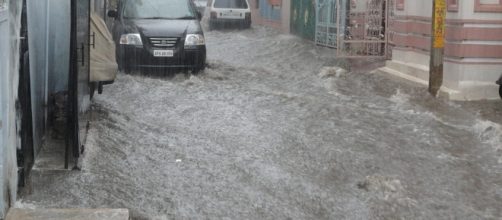Hurricane Harvey is gone, but it left billions of dollars of infrastructural damage and severe flooding in its wake. But, what if a lot of it could have been prevented? The Dallas Morning News obtained a report that shows a $400 million dollar proposal to help reduce flooding in Harris County.
Proposals to ease flooding in Houston,Texas
The document states that although the usually dry Addicks and Barker reservoirs were serving their purpose in the 1940s, a sharp population increase around the reservoirs, threatened failure of the systems. Engineers from the Harris County flood Control District suggested that major changes be effected to prevent epic flooding in the Houston region.
These included building a massive eight channel underground conduit, that would carry water from the reservoirs to the Houston Ship Channel, far away from populated areas. Other solutions suggested digging the reservoirs deeper, imposing new regulations on development, or buying out properties at risk of flooding.
For some reason, the report was filed away and nothing was done. Following Harvey’s devastation, the flood control district's Chief Engineer Steve Fitzgerald was asked why no action was taken. He admitted that he hadn’t read the report in a very long time, but believed the changes would have been very difficult to do at that time. In spite of his words, the report paints a different story.
According to its writers, 1996 was the perfect time to effect change since the Katy Freeway was being reconstructed by the Texas Department of Transportation. A suitable route for the proposed drainage channel could have easily been found, since a part of Interstate 10 west of downtown Houston, leads “directly from the two reservoirs to the downtown section”.
Playing the blame game
Hurricane Harvey brought with it unprecedented levels of water that not only caused damage to nearly everything in its path, but also caused Houston to sink. Such evidence was revealed on Monday by Chris Milliner of the Jet Propulsion Laboratory, who said the region was pushed down about two centimeters by water weight.
In a map he published on Twitter, Milliner used data from the Nevada Geodetic Laboratory to show the actual damage done. As forecast in the 1996 report, the Addicks and Barker reservoirs filled quickly and its floodgates were opened by the Army Corps of Engineers. However, instead of releasing 4,000 cubic feet per second, the gates were widened further to prevent rising water levels from topping the dams. This resulted in more than 13,000 cubic feet of water escaping and flooding many neighborhoods downstream.
Buffalo Bayou is now suing the Corps for condemning their west Houston properties, by allowing flood waters to flow downstream. Corps officials, however, are blaming Congress for not allocating enough funds to have had the necessary reconstruction work done on the reservoir. Harris County Commissioner Steve Radack said that had money flowed from Government officials like the floodwaters, the problem facing them today, would not be so dire.


